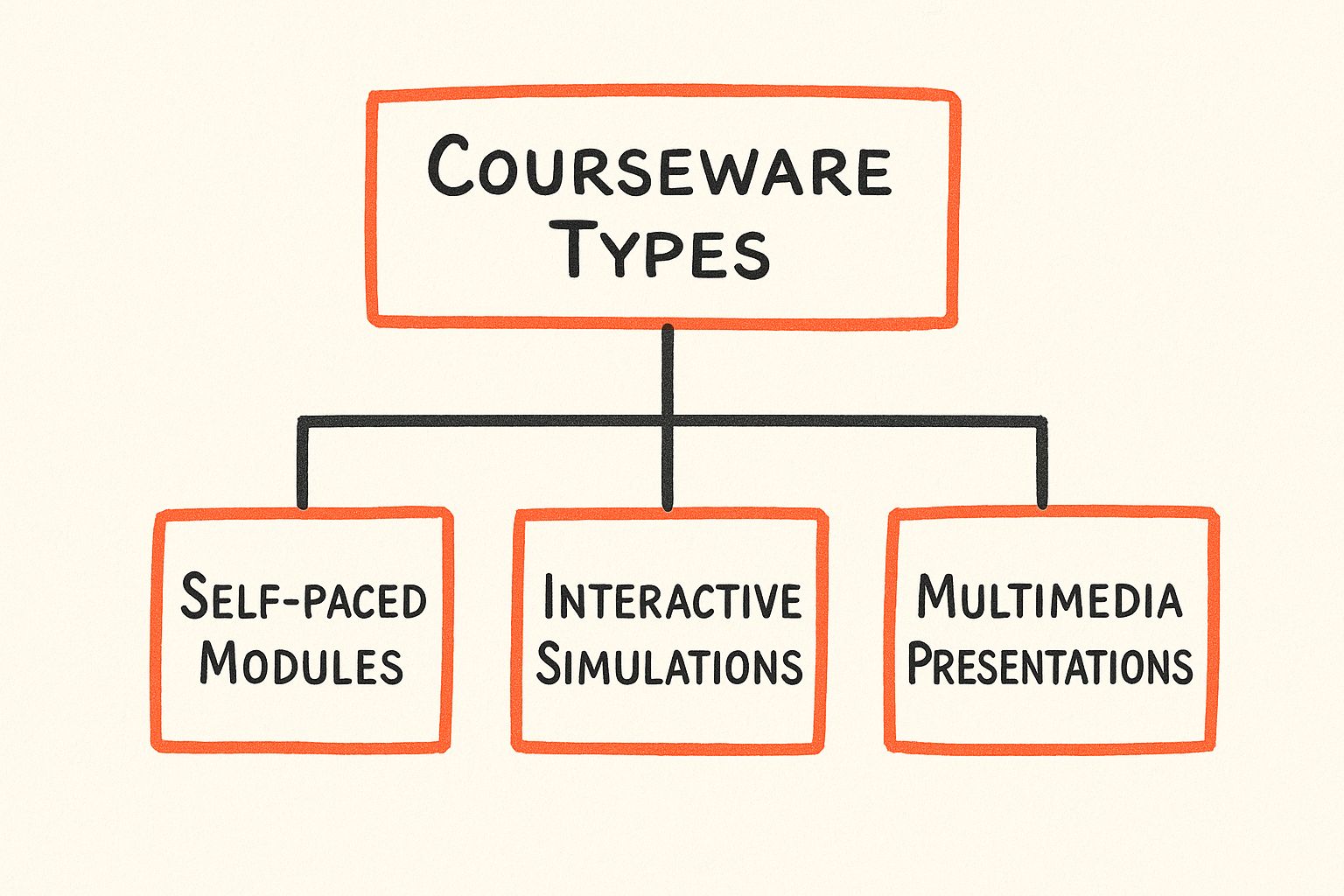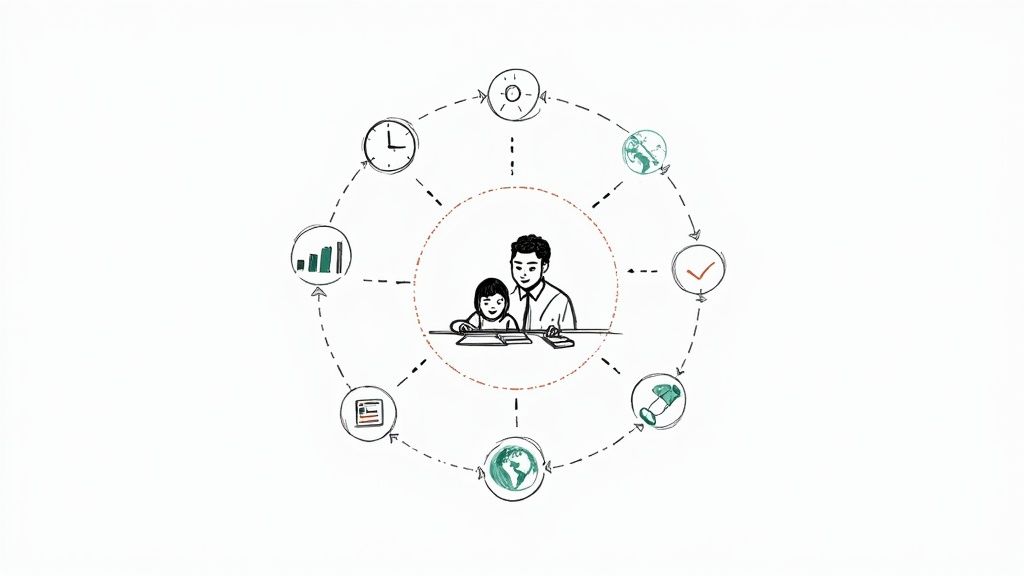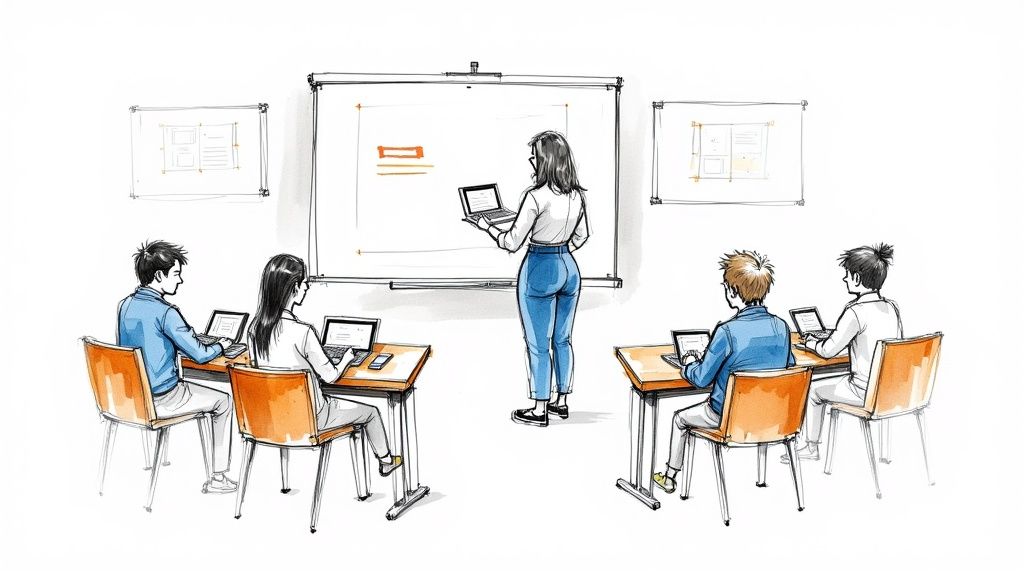Let's be real, the term 'courseware' sounds a little stiff and corporate, doesn't it? But what are we actually talking about?
Think of it like this: courseware is the complete, all-in-one digital package for learning a specific subject. It bundles everything a person needs—lessons, activities, quizzes, maybe even simulations—into a single, structured experience, often created with powerful authoring tools like Articulate Suite or Adobe Captivate.

Courseware is the engine that powers most of the online learning you see today. It’s way more than just a PDF document or a playlist of videos. It's a carefully crafted educational journey, combining instructional design theory with modern technology. Its main goal is to take a pile of raw information and turn it into a guided path that’s actually effective and, dare I say, fun for the learner.
This structured approach is making huge waves in both education and corporate training. In the United States alone, the courseware market is expected to grow by a massive USD 1.00 billion between 2023 and 2028. It’s a big deal.
At its heart, courseware is the difference between handing someone a book and giving them a personal tutor. One just gives you the facts; the other guides you toward genuine understanding.
The real power of courseware comes from how it's built. Instructional designers blend educational theory with software to assemble these digital kits, focusing on making them interactive and intuitive. The whole point is to create a smooth flow that helps people not just see the information, but actually absorb and remember it.
So, what goes into a typical courseware package? It's all about a few key elements working in harmony:
To put it simply, modern courseware is a collection of thoughtfully designed pieces that come together to create a cohesive learning experience.
This handy table breaks down the core elements.
That last point about technical standards is pretty important. It ensures the course can be tracked and managed properly. If you’ve heard the term but aren’t quite sure what it means, we have a whole guide that explains what a SCORM package is and why it's a game-changer.
Ultimately, great courseware doesn't just throw information at you. It creates an entire environment built for learning.
Great courseware isn't just a jumble of videos and PDFs. It's a thoughtfully crafted learning experience built on sound instructional design theory. I like to think of an instructional designer as an architect, using specific building blocks to construct something that’s not only sturdy but also engaging to be in. Every piece is designed to work together, guiding a learner from "I have no idea" to "I've totally got this."
It all starts with a solid blueprint—instructional design theory. These are the educational ground rules that make sure the content actually works and people learn from it. You can dive deeper into the core principles of instructional design to see how these foundational ideas shape the whole creation process.
Once the plan is in place, designers grab their digital toolkit to bring it to life. This is where authoring tools come in. Think of software like Articulate Suite or Adobe Captivate as the high-powered equipment in our workshop. They let us build rich, interactive content that goes way beyond a simple slideshow.
These tools are what we use to build the most impactful parts of modern courseware:
This is a great way to visualize how these different courseware types fit together.

As you can see, courseware isn't a one-size-fits-all thing. It can range from straightforward presentations to complex modules that practically read the learner's mind.
The real magic happens when you mix and match these elements. A single course could kick off with an engaging multimedia presentation, transition into a self-paced module with quick knowledge checks, and finish with a hands-on simulation where learners have to apply everything they just learned.
By blending solid learning theory with powerful software, we create courseware that’s so much more than the sum of its parts. It becomes a living, breathing tool that makes learning stick.

So, you’ve poured your heart and soul into creating an amazing course. That's a huge win, but it's really just step one. Now, how do you actually get it into the hands of your learners?
Without a solid delivery system, even the most beautifully designed course made in Articulate Suite or Adobe Captivate is just a collection of files gathering digital dust. This is where learning platforms come in—they are the digital classrooms that connect your content to your audience.
When it comes to delivering courseware, you’ll mainly hear about two types of platforms: the Learning Management System (LMS) and the Learning Experience Platform (LXP). They might sound similar, but they approach learning from completely different angles.
An LMS is like the trusty, organized administrator of the learning world. It’s built for top-down management. Think of it as the go-to for assigning required training, tracking course completions for compliance, and managing formal educational paths. You can learn more about the different types of learning management systems in our other guide.
An LXP, by contrast, is more like a personalized learning library or a streaming service. It puts the learner in control. Instead of just pushing out required courses, it uses AI to recommend content based on an individual's skills, interests, and career goals. It’s all about discovery and self-guided learning.
An LMS tells you what you have to learn. An LXP helps you discover what you want to learn. Both are essential for a well-rounded learning strategy.
Ultimately, picking the right platform is critical. A great online course platform comparison guide can help you weigh your options. Whether you need a structured system or a more exploratory one, the end goal is the same: making sure your valuable courseware actually finds and engages its audience.
Courseware isn't a stagnant field—far from it. It’s constantly evolving as instructional design theory gets supercharged by new technology. What we're seeing now is a new wave of learning experiences that are smarter, faster, and way more personal than ever before.
The whole eLearning market, which is built on the back of great courseware, was already worth around USD 200 billion in the early 2020s. Projections show it could double to an incredible USD 400 billion by 2026. This isn't just growth; it's a fundamental shift in how people learn. You can dig into more stats on this booming market over at DevlinPeck.com.
So, what’s actually driving all this change? A few key trends are weaving together technology and theory in the instructional design world.
The biggest game-changer right now is easily Artificial Intelligence (AI). We're moving away from the old one-size-fits-all lesson plan. Instead, AI-powered courseware can create truly adaptive learning paths for every single person.
Think about it this way: imagine a system notices someone is stumbling on a specific concept in a quiz. Instead of just slapping them with a "you failed" message, the courseware can instantly offer up a different video or maybe a hands-on activity to help them nail down that one skill. This turns a straight-line lesson into a dynamic, personalized journey that adjusts on the fly, a bit like having a personal tutor.
AI in courseware shifts the focus from "Did you complete the module?" to "Did you truly understand the material?" It's a fundamental change that prioritizes mastery over mere completion.
Another huge trend is Microlearning. Let's be honest, we live in a world of short attention spans and packed schedules. Microlearning gets this and delivers content in small, focused chunks. We're talking five-minute videos, quick interactive quizzes, or infographics that explain one concept.
This approach just fits better with how we work today. An employee can squeeze in a quick lesson while waiting for a meeting to start, rather than having to block out a whole hour for training. It makes learning feel more manageable and actually helps with retention by not overwhelming the brain.
Authoring tools like the Articulate Suite and Adobe Captivate are keeping up with these trends. They've rolled out features that make it much easier for instructional designers to build more dynamic content, including:
By mixing powerful software with smart learning ideas like AI and microlearning, designers are now able to build courseware that isn't just a dump of information, but a genuinely effective and personalized experience.

So, what's the actual payoff here? Forget the buzzwords for a second. Companies are investing in courseware for a pretty simple reason: it gets results. It's the engine that builds a skilled, sharp, and unified team ready for whatever comes next.
The biggest win right off the bat is consistency. Imagine a company onboarding new hires in ten different offices across the globe. Courseware guarantees that every single person gets the same top-notch training. This gets rid of that old "game of telephone" problem where critical info gets watered down or twisted, ensuring everyone starts with the same solid foundation.
As a company gets bigger, training can quickly turn into a logistical mess. This is where well-built courseware really shines with its incredible scalability. You can build one amazing course and roll it out to ten employees or ten thousand. Everyone gets the same high-quality experience without the cost and effort ballooning.
Then there’s the data—and this is a game-changer. When you deliver courseware through a Learning Management System (LMS) or a Learning Experience Platform (LXP), you can track just about everything.
Suddenly, training isn't a shot in the dark; it's a data-driven strategy. You can see exactly where people are getting stuck, measure how much they’re actually retaining, and draw a straight line from learning outcomes to business goals.
This smart, measurable approach is a huge reason the EdTech market, where courseware is a star player, hit a staggering USD 163.49 billion valuation in 2024. And it’s not slowing down, with projections to blow past USD 348 billion by 2030. If you want to dive deeper, you can explore the data on grandviewresearch.com.
At the end of the day, this is all about building a better team. Whether it’s for corporate training or a university curriculum, a smart courseware strategy leads to real, tangible improvements. To get a feel for just how wide-ranging this is, check out the different e-learning and training use cases where it’s making a difference.
The bottom line is simple: organizations use courseware because it helps them build a more competent, confident, and prepared workforce that directly drives business value.
Even after getting the basics down, a few questions always seem to pop up about courseware. Let's tackle the most common ones so you can see how everything fits together in the instructional design world.
Nope, but they're the ultimate power couple.
Here’s a simple way to think about it: courseware is the movie, and a Learning Management System (LMS) is the Netflix or Hulu that plays it.
The courseware itself is all the good stuff—the lessons, the videos, the quizzes you actually engage with. The LMS is the software that hosts, delivers, and keeps track of who’s watched what and how they did. They're two different things, but they work hand-in-hand to make online learning happen.
Technically, sure. But there’s a world of difference between throwing some slides together in PowerPoint and crafting truly effective courseware. It's like the difference between a home video and a feature film.
Professional instructional designers rely on specialized authoring tools like the Articulate Suite or Adobe Captivate to build polished, interactive learning experiences. They’re not just dumping information onto a screen; they’re using proven learning theories to structure content in a way that actually sticks.
The magic of professional courseware isn't just in the information it holds, but in the thoughtful design that guides someone from confusion to genuine understanding.
These two get mixed up all the time, and for good reason. The difference is subtle but important.
"Online course" is a really broad term. It could be anything from a few YouTube videos to a university-level program. "Courseware," however, usually refers to something much more specific: a complete, self-contained package of digital learning materials built to hit a specific goal. Think of it as a polished, reusable, and trackable learning module that often includes interactive elements, assessments, and extra resources all bundled together.
Artificial Intelligence (AI) is making courseware a lot more personal and a whole lot smarter. Instead of a one-size-fits-all approach where everyone clicks through the same screens, AI can create a learning path that adapts to each individual.
For instance, an AI-powered system can see how you’re doing on a quiz in real time. If you’re struggling with a particular idea, it might automatically offer up a different video, a simpler explanation, or a hands-on activity to help you get it right. This is a huge leap forward, moving us from generic content to a truly personalized journey where everyone gets the support they actually need.
Ready to build a skilled and agile team with effective digital learning? At Relevant Training, we specialize in developing and updating eLearning content that drives real results for small and medium-sized businesses. Explore our services at https://relevant.training.